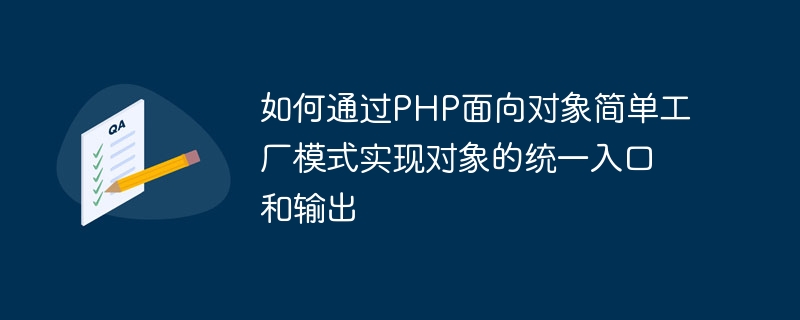

How to realize unified entry and output of objects through PHP object-oriented simple factory pattern
Introduction:
In PHP development, by using object-oriented programming (Object -Oriented Programming (OOP) can improve the maintainability and scalability of the code. Object-oriented design pattern is a widely used method that can help us better organize and manage code. In this article, we will focus on how to achieve unified entry and output of objects by using the PHP object-oriented simple factory pattern.
1. What is the simple factory pattern?
The simple factory pattern is a commonly used object-oriented design pattern that creates objects through a factory class instead of directly using the new keyword to create objects in the code. The advantage of this is that it can encapsulate the object creation process, thereby reducing the coupling of the code and providing better scalability.
2. Example Scenario
In order to better understand the application of the simple factory pattern, we assume that there is a website that needs to generate different welcome messages according to different user types. For example, for ordinary users, we output "Welcome to our website!", and for VIP users, we output "Welcome VIP users to our website!".
3. Implementation steps
abstract class User { abstract public function welcome(); }
class OrdinaryUser extends User { public function welcome() { echo "欢迎访问我们的网站!"; } }
class VipUser extends User { public function welcome() { echo "欢迎VIP用户访问我们的网站!"; } }
class UserFactory { public static function createUser($type) { switch ($type) { case 'ordinary': return new OrdinaryUser(); case 'vip': return new VipUser(); default: return null; } } }
$user = UserFactory::createUser('ordinary'); $user->welcome(); // 输出:欢迎访问我们的网站! $user = UserFactory::createUser('vip'); $user->welcome(); // 输出:欢迎VIP用户访问我们的网站!
4. Summary
Through the code implementation in the above example, we can see that the simple factory pattern can achieve unified entry and output of objects. Through the factory class, we can obtain different objects according to different parameters without directly using the new keyword to create objects in the code. The advantage of this is that it can reduce the coupling of the code and provide better scalability and maintainability. In actual development, we can flexibly use the simple factory pattern according to specific needs to improve the quality and efficiency of the code.
The above is the detailed content of How to realize unified entry and output of objects through PHP object-oriented simple factory pattern. For more information, please follow other related articles on the PHP Chinese website!




